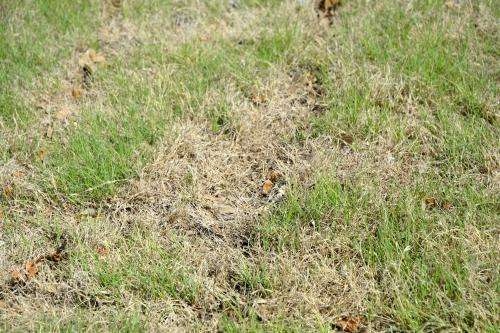AgriLife Research expert: Drought, water limitations survivable by turfgrasses

Many areas of Texas are having water shortages in the continuing drought, and a big concern is the inability to irrigate turfgrass, whether that is due to lack of water or municipality restrictions.
Homeowners are asking: What is my turf going to look like; will it come back?
Dr. Richard White, Texas A&M AgriLife Research turfgrass management scientist in College Station, said the answer is yes, with patience and a little water to keep growing points alive.
"We have a difficult time changing home consumers' behavior in terms of how they apply water sometimes," White said. "That's the big reason you see so much water being used in landscapes. If they would tolerate potential 75-80 percent attrition during these dry times – the 20-25 percent of the growing points left will help rejuvenate the lawn once the rains return."
The bottom line is time, White said. That will tell the degree of damage that occurred.
"It may look pretty severe initially, particularly early summer, but I would just encourage folks to be patient to see what will happen. Provide small amounts of water if you can and don't go overboard."
"We are really just coming out of winter and some areas have been affected by cold temperatures as well as dry conditions," White said. "Predicting the success of that grass surviving or coming out of those conditions is a little hard, but many of the turfgrasses we grow, including some of the native species, will go into a dormancy mechanism and survive severe drought conditions."
He said when the drought is combined with cold winter weather; sometimes plants suffer more winter kill and won't recover well.
"The key is, I think, how much we are allowed to irrigate," White said. "We might have to greatly restrict what we apply or it could be restricted by the municipality.
"But, if we can apply water even in small amounts, a quarter of an inch or a half of an inch every two weeks or so, that will provide an advantage to keep the growing points alive and prevent them from drying up."
Turf grasses and other perennial grasses have the potential to recover as long as those growing points are kept alive, he said.
White said an experiment was conducted in College Station from 2011-2013 with St. Augustine grass. The summer of 2011 was one of the hottest on record in Texas, and the St. Augustine grass studied was irrigated with very small amounts of water relative to the evaporative demand required.
"We lost about 75-80 percent of the green cover in one treatment," he said. "There were enough growing points kept alive, though, that by July of the following year, with a little rainfall and small amounts of irrigation, it had recovered to 100 percent.
"So there is potential for grasses to recover as long as we are patient and as long as we can accept some attrition to the plant and don't always require that jalapeno green color year round," White said.
"We can often get the turf back after periods of dry weather. You just have to be a little patient and don't give up on it."
White explained that water use is one thing when talking about turfgrass; water requirements are different. Water use is what goes out through the stomata; while water requirements are different and can be set according to differing objectives.
"Do we want to maintain jalapeno green grass? If so, the water requirement will be very high and require maximum irrigation. Do we want to just maintain acceptable green color; or do we want to let it go dormant until conditions return to more normal and we get adequate moisture so they can start active growth again?"
With the water requirements currently, the evapotranspiration-based irrigation systems suggest using an irrigation co-efficient of 0.6 for warm-season grasses and for cool-season grasses it would be 0.8 and those are built into the texasET.tamu.edu network.
"We have a lot we can do to conserve water if we are irrigating based on science, rather than a clock," White said. "Our studies show that 25 percent of the population irrigating landscapes use 50 percent of all the potable water consumed within a municipality because they are not well-versed on irrigation of lawns and landscapes.
"There's a huge opportunity for us to get the word out and help set irrigation systems up for homeowners for water savings. Some are putting 20 to 24 inches a month of irrigation on their landscape. We have to do a better job educating homeowners on conserving and reducing the amount we use."
Provided by Texas A&M University



















